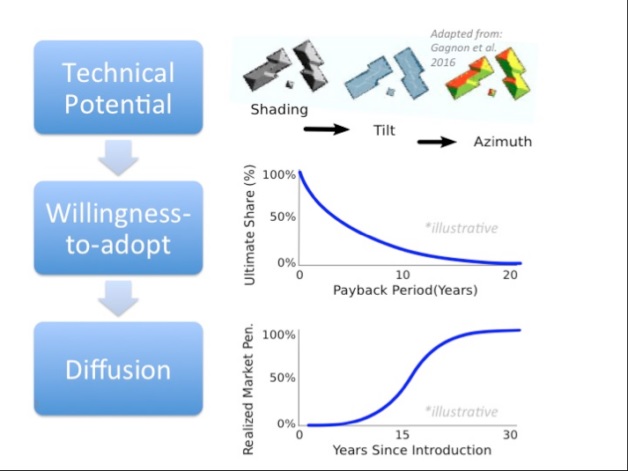Nine Innovative Approaches That Utilities are Using to Plan for Increased Rooftop Solar
Berkeley Lab-led report offers a comparative analysis of roughly 30 recent utility integrated resource plans or other generation planning studies, transmission planning studies, and distribution system plans
Washington, D.C. – (RealEstateRama) — When an individual utility customer decides to add rooftop solar to their home or business, the utility needs to deliver less power to that customer from other sources. A small number of solar adopters may not have much of an impact, but rapid growth in rooftop solar in some parts of the country has the potential to significantly impact the need for generating resources and transmission and distribution (T&D) infrastructure.

To account for these changing needs, utilities are increasingly incorporating rooftop solar into their planning practices.
A new report by researchers from Lawrence Berkeley National Laboratory (Berkeley Lab) and the National Renewable Energy Laboratory surveys utility planning practices from roughly 30 studies across the United States. The rapid growth of rooftop solar has not been distributed equally across U.S. utility territories, and the same is true for projected future growth. While some of the studies forecast rooftop solar to be equivalent to 5% or more of retail sales by 2020, fewer than half consider penetrations beyond 1% by 2020. As a result, utilities and other planning organizations have differed in their perceptions about the need to incorporate rooftop solar into resource and T&D plans. Because of this staggered progress, organizations that are just beginning to address rooftop solar can draw on innovative practices from organizations that already are incorporating rooftop solar rigorously into their plans. In this report, “Planning for a Distributed Disruption: Innovative Practices for Incorporating Distributed Solar into Utility Planning,” the researchers highlight these innovative planning approaches across nine methodological areas.

One of the challenges utilities face with incorporating solar into planning studies is that customer decisions are central to where and when rooftop solar is adopted in most cases. An innovative approach to incorporating these decisions into utility planning is to use a customer adoption model that accounts for the available rooftop space, the customer economics of rooftop solar, and the diffusion of new technologies into the market.
Utility planners can further use customer demographic factors, like income, homeownership, and energy use to pinpoint which homes will most likely adopt solar.
Bringing forecasts of customer adoption of rooftop solar into utility planning is essential to realizing the full value of solar and ensuring reliable operation of the power system.
Projecting rooftop solar adoption can be difficult, but innovations in utility planning decisions can help to account for this uncertainty. Planners do this by separating decisions that do not depend on how much rooftop solar is adopted from those that do. The planners can then identify trigger events (e.g., threshold levels of rooftop solar adoption) that will affect the need and timing for particular resources or assets, like a new gas fired generator, to be built.
Utilities are also considering distributed solar—sited on customer roofs or elsewhere on the distribution system—as a resource that can be used to meet projected utility needs. An innovative approach to making these decisions is for the utilities to characterize a wide range or costs and benefits of distributed solar, including factors like the potential for reduced electricity losses and deferral of transmission and distribution upgrades.
Fully integrating distributed solar into utility planning requires more tightly linking distribution, transmission, and resource planning. A few states and regions—including California, New York, and New England—have started to develop these more comprehensive processes, but there are still many issues to address. Understanding the range of different approaches across the United States and highlighting innovative practices should help accelerate those changes.
This work was supported by the U.S. Department of Energy’s SunShot Initiative, part of the Office of Energy Efficiency and Renewable Energy.
# # #
Lawrence Berkeley National Laboratory addresses the world’s most urgent scientific challenges by advancing sustainable energy, protecting human health, creating new materials, and revealing the origin and fate of the universe. Founded in 1931, Berkeley Lab’s scientific expertise has been recognized with 13 Nobel prizes. The University of California manages Berkeley Lab for the U.S. Department of Energy’s Office of Science. For more, visit http://www.lbl.gov.
DOE’s Office of Science is the single largest supporter of basic research in the physical sciences in the United States, and is working to address some of the most pressing challenges of our time. For more information, please visit science.energy.gov.
The U.S. Department of Energy SunShot Initiative is a collaborative national effort that aggressively drives innovation to make solar energy fully cost-competitive with traditional energy sources before the end of the decade. Through SunShot, the Energy Department supports efforts by private companies, universities, and national laboratories to drive down the cost of solar electricity to $0.06 per kilowatt-hour. Learn more at energy.gov/sunshot.
Contact:
Jon Weiner
510-486-4014














